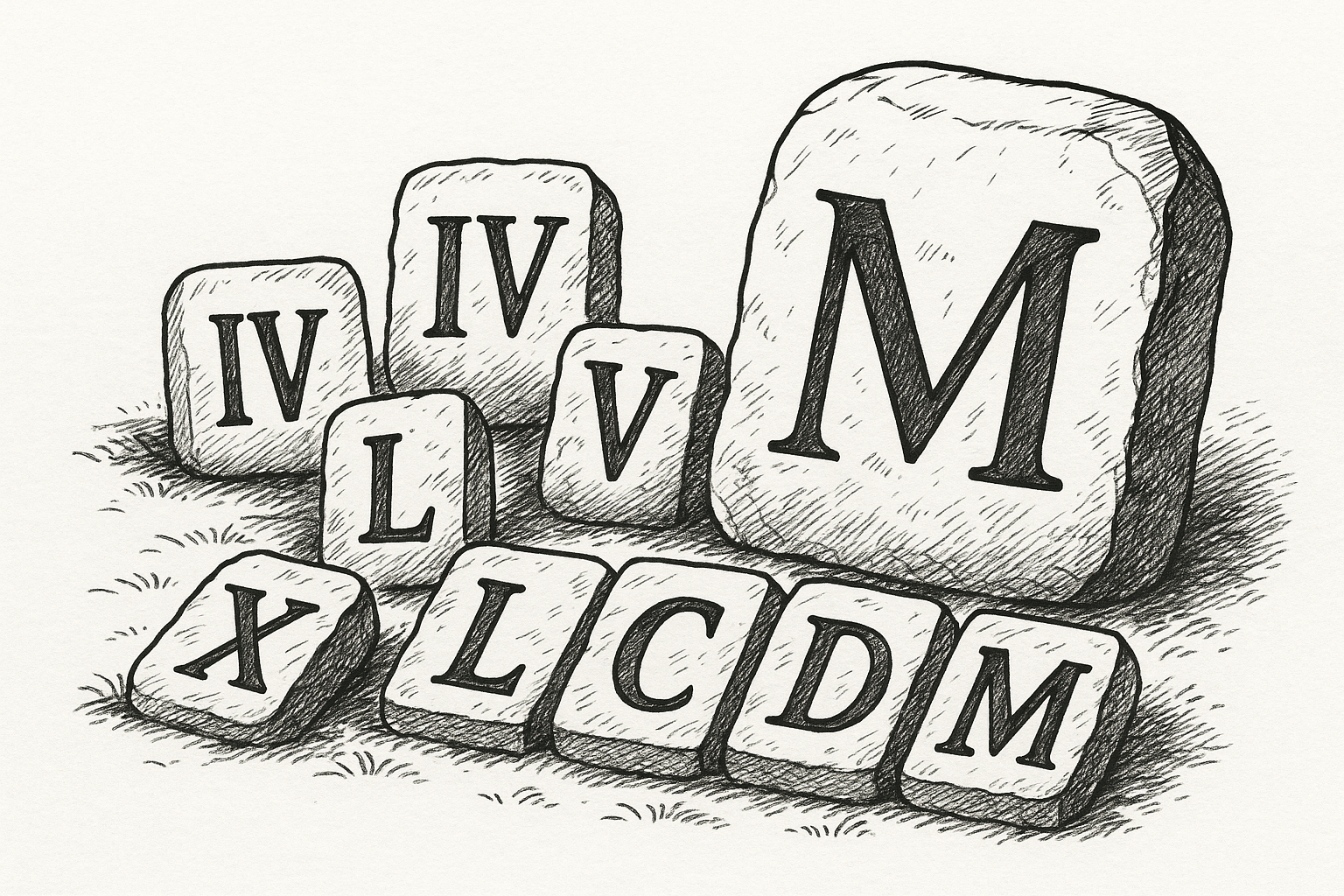How to Write Large Numbers with Roman Numerals

Roman numerals originated thousands of years ago in ancient Rome, initially designed for ease in engraving on monuments and public works. Today, while not practical for mathematical calculations, understanding how to write large numbers with Roman numerals remains valuable, especially in historical, ceremonial, and decorative contexts.
This article explains the methods Romans used to express large numbers clearly and systematically. You will learn the rules, see examples, and discover where these high-value Roman numerals are still in use today.
Basics of Roman Numerals
Before diving into large numbers, let’s quickly revisit the foundational Roman numerals and their values:
- I = 1
- V = 5
- X = 10
- L = 50
- C = 100
- D = 500
- M = 1000
Combining these symbols allows you to form virtually any number, employing rules of addition and subtraction. However, standard Roman numerals become cumbersome beyond a few thousand.
Using Overlines (Vinculum) to Write Large Numbers
To simplify large numbers, Romans introduced an additional notation: a horizontal line (known as a vinculum or overline) above numerals. This line multiplies the numeral’s value by 1,000. For example:
- V̅ = 5,000
- X̅ = 10,000
- L̅ = 50,000
- C̅ = 100,000
- D̅ = 500,000
- M̅ = 1,000,000
This system efficiently allowed Romans to represent very large numbers in a compact format. For instance, the number 4,000 is written as IV̅ (4 × 1,000).
Examples of Large Roman Numerals
To better understand this method, consider these examples:
- 5,000 = V̅
- 10,000 = X̅
- 40,000 = X̅L̅ (50,000 – 10,000)
- 100,000 = C̅
- 400,000 = C̅D̅ (500,000 – 100,000)
- 1,000,000 = M̅
Complex combinations are also possible:
- 7,890 = V̅MMMDCCCXC (5,000 + 2,000 + 500 + 300 + 90)
- 12,345 = X̅MMCCCXLV (10,000 + 2,000 + 300 + 40 + 5)
Rules for Writing Large Numerals
When using Roman numerals for large numbers, certain rules must be observed:
- Overlines multiply by 1,000, and double overlines multiply by 1,000,000.
- Standard Roman numeral rules of addition and subtraction still apply beneath the overline.
- Repeating symbols beyond three times is generally avoided, using subtraction combinations instead.
For example, the number 9,000 is not written as VIIII̅, but as IX̅.
Modern Limitations and Alternatives
Despite their historical and aesthetic appeal, Roman numerals become challenging in practical modern usage, especially digitally, due to typing difficulties and readability concerns. Therefore, modern applications typically limit their use to numbers below 4,000 (MMMCMXCIX).
In digital environments, alternatives to the vinculum notation include using parentheses or brackets around numerals to indicate multiplication by 1,000:
- (V) = 5,000
- (X) = 10,000
This method is unofficial but helps maintain readability and ease in modern contexts.
Where Are Large Roman Numerals Still Used?
Large Roman numerals primarily appear today in ceremonial, historical, and decorative contexts:
- Historical monuments and buildings, recording significant dates.
- Inscriptions and commemorations on plaques and cornerstones.
- Formal documentation, certificates, and certain academic contexts.
Their continued usage conveys formality, significance, and traditional elegance.
Why Learn to Write Large Numbers in Roman Numerals?
Understanding large Roman numerals enriches your cultural literacy, providing insight into ancient numbering systems and historical contexts. Additionally, familiarity with this system enhances your ability to interpret historical documents, monuments, and cultural references more deeply.
Roman numerals also offer aesthetic value, commonly used in graphic design, branding, and artistic projects where traditional sophistication and classical style matter.
Conclusion
Learning how to write large numbers with Roman numerals provides an appreciation of historical methods for numerical notation and offers practical knowledge for reading and interpreting historical and ceremonial contexts. While not practical for calculations, large Roman numerals still hold value for symbolic, cultural, and aesthetic reasons.
Use our Roman numeral converter tool and charts to further explore and master these classical numerals, whether for education, professional projects, or personal enrichment.
Roman numerals originated thousands of years ago in ancient Rome, initially designed for ease in engraving on monuments and public works. Today, while not practical for mathematical calculations, understanding how to write large numbers with Roman numerals remains valuable, especially in historical, ceremonial, and decorative contexts.
This article explains the methods Romans used to express large numbers clearly and systematically. You will learn the rules, see examples, and discover where these high-value Roman numerals are still in use today.
Basics of Roman Numerals
Before diving into large numbers, let’s quickly revisit the foundational Roman numerals and their values:
- I = 1
- V = 5
- X = 10
- L = 50
- C = 100
- D = 500
- M = 1000
Combining these symbols allows you to form virtually any number, employing rules of addition and subtraction. However, standard Roman numerals become cumbersome beyond a few thousand.
Using Overlines (Vinculum) to Write Large Numbers
To simplify large numbers, Romans introduced an additional notation: a horizontal line (known as a vinculum or overline) above numerals. This line multiplies the numeral’s value by 1,000. For example:
- V̅ = 5,000
- X̅ = 10,000
- L̅ = 50,000
- C̅ = 100,000
- D̅ = 500,000
- M̅ = 1,000,000
This system efficiently allowed Romans to represent very large numbers in a compact format. For instance, the number 4,000 is written as IV̅ (4 × 1,000).
Examples of Large Roman Numerals
To better understand this method, consider these examples:
- 5,000 = V̅
- 10,000 = X̅
- 40,000 = X̅L̅ (50,000 – 10,000)
- 100,000 = C̅
- 400,000 = C̅D̅ (500,000 – 100,000)
- 1,000,000 = M̅
Complex combinations are also possible:
- 7,890 = V̅MMMDCCCXC (5,000 + 2,000 + 500 + 300 + 90)
- 12,345 = X̅MMCCCXLV (10,000 + 2,000 + 300 + 40 + 5)
Rules for Writing Large Numerals
When using Roman numerals for large numbers, certain rules must be observed:
- Overlines multiply by 1,000, and double overlines multiply by 1,000,000.
- Standard Roman numeral rules of addition and subtraction still apply beneath the overline.
- Repeating symbols beyond three times is generally avoided, using subtraction combinations instead.
For example, the number 9,000 is not written as VIIII̅, but as IX̅.
Modern Limitations and Alternatives
Despite their historical and aesthetic appeal, Roman numerals become challenging in practical modern usage, especially digitally, due to typing difficulties and readability concerns. Therefore, modern applications typically limit their use to numbers below 4,000 (MMMCMXCIX).
In digital environments, alternatives to the vinculum notation include using parentheses or brackets around numerals to indicate multiplication by 1,000:
- (V) = 5,000
- (X) = 10,000
This method is unofficial but helps maintain readability and ease in modern contexts.
Where Are Large Roman Numerals Still Used?
Large Roman numerals primarily appear today in ceremonial, historical, and decorative contexts:
- Historical monuments and buildings, recording significant dates.
- Inscriptions and commemorations on plaques and cornerstones.
- Formal documentation, certificates, and certain academic contexts.
Their continued usage conveys formality, significance, and traditional elegance.
Why Learn to Write Large Numbers in Roman Numerals?
Understanding large Roman numerals enriches your cultural literacy, providing insight into ancient numbering systems and historical contexts. Additionally, familiarity with this system enhances your ability to interpret historical documents, monuments, and cultural references more deeply.
Roman numerals also offer aesthetic value, commonly used in graphic design, branding, and artistic projects where traditional sophistication and classical style matter.
Conclusion
Learning how to write large numbers with Roman numerals provides an appreciation of historical methods for numerical notation and offers practical knowledge for reading and interpreting historical and ceremonial contexts. While not practical for calculations, large Roman numerals still hold value for symbolic, cultural, and aesthetic reasons.
Use our Roman numeral converter tool and charts to further explore and master these classical numerals, whether for education, professional projects, or personal enrichment.





